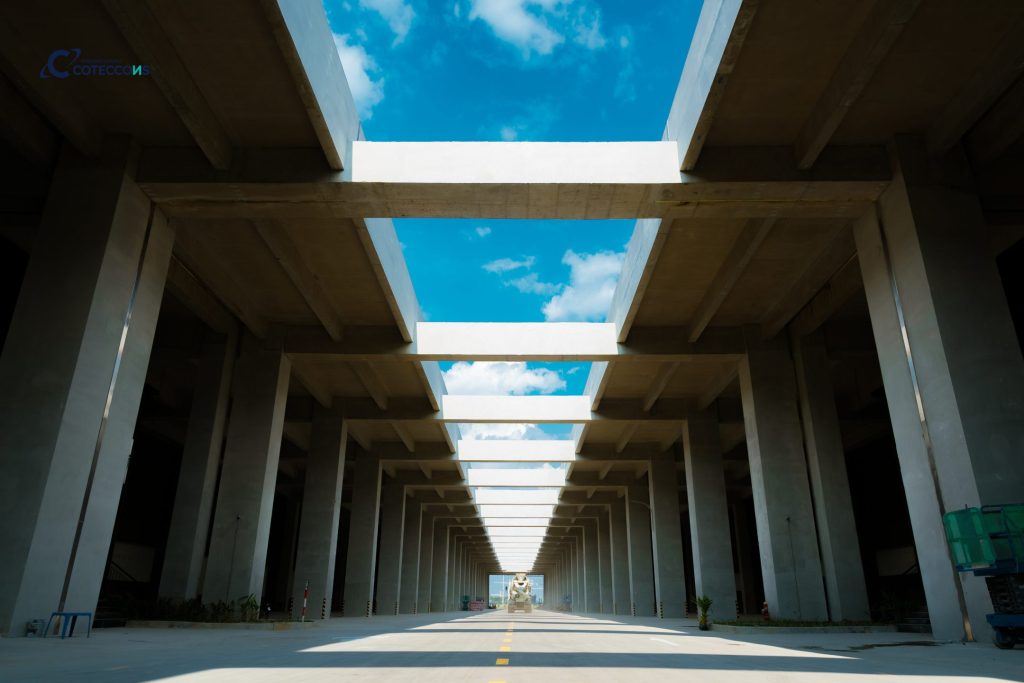At the Shareholders’ Day event on September 20, 2025, Coteccons’ Chairman – Mr. Bolat Duisenov delivered candid insights on the company’s strategy and long-term vision, beginning with three keywords that he believes will shape not only the construction sector but also the trajectory of Vietnam’s economy in the decades ahead.
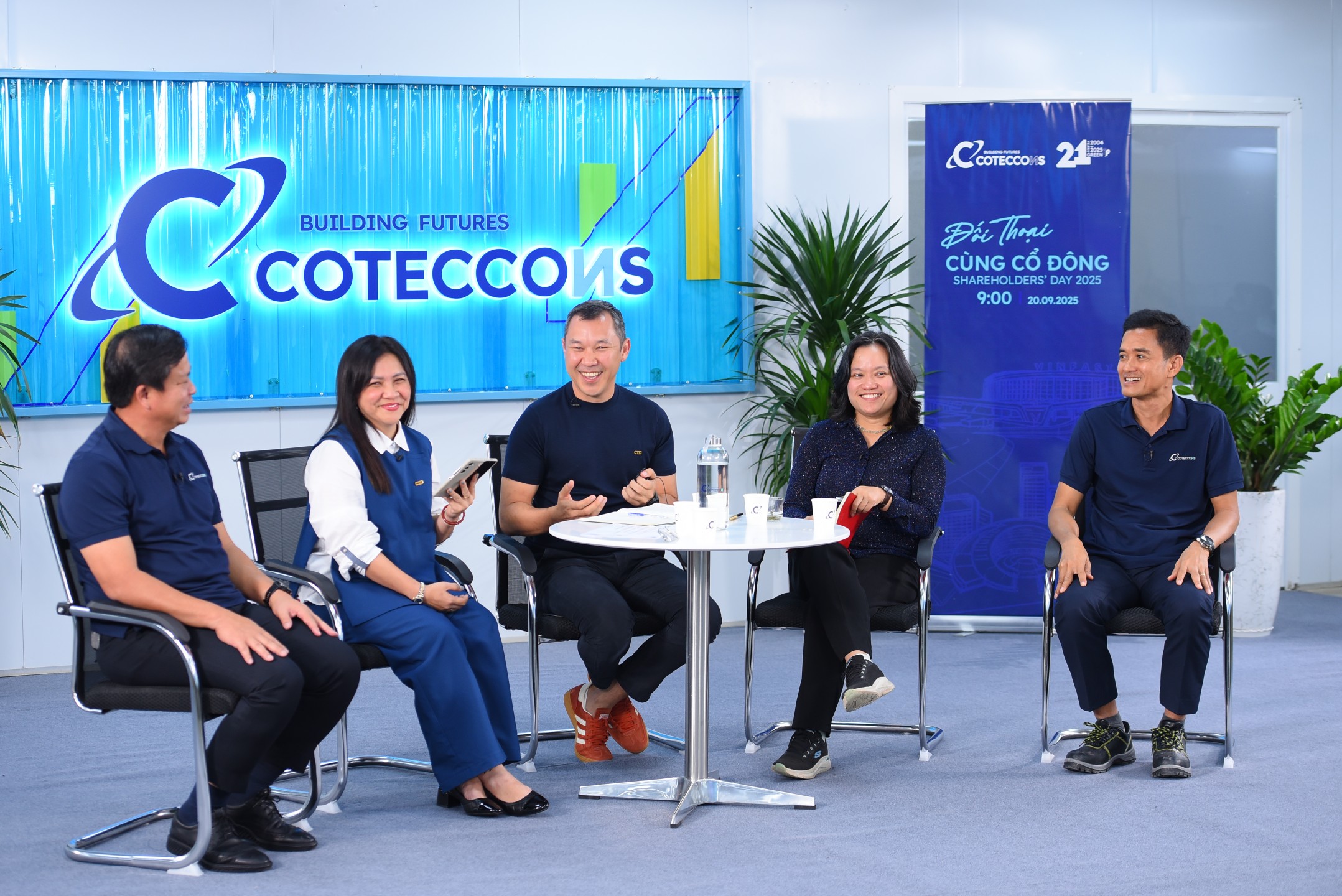
On September 20, 2025, Coteccons held its Annual Shareholders’ Day at the construction site of the APEC Convention Center project in Phu Quoc.
Opening the dialogue, Chairman Bolat Duisenov outlined an ambitious 20-year vision for Coteccons, aligned with the country’s development, beginning with the keyword Urbanization. He highlighted that with Vietnam’s current urbanization rate at 40%, the nation stands at a similar stage to where China was two decades ago. This not only signals vast growth potential but also presents significant opportunities for the construction industry to shape an integrated infrastructure ecosystem — spanning roads, bridges, airports, hospitals, and schools.
Continuing on the growth trajectory, Mr. Bolat emphasized the theme of Industrialization. Vietnam is emerging as a regional “industrial hub,” attracting over 60% of total FDI into manufacturing and high-tech sectors. With advantages in a young and skilled workforce, strategic geographic location, and strong government support, well-prepared and capable construction companies are positioned to seize this golden opportunity.

The final cornerstone of the strategic vision is Globalization. As Vietnam’s position on the international stage continues to strengthen, Coteccons is boldly venturing into the vast ocean. With projects already executed and underway in Laos, Cambodia, Myanmar, India, and Taiwan, and plans expanding into the United States, Kazakhstan, and Saudi Arabia, Coteccons is steadily realizing its ambition of becoming a world-class construction company — confidently demonstrating that Vietnamese engineers and management systems stand on par with international competitors.
“Carving away the flesh, retaining the muscle, stripping out the fat.”
- Chairman Bolat Duisenov has been speaking about the Go Global strategy for several years now. When will we actually see this materialize, and is that the reason why Coteccons’ stock has yet to make a significant breakthrough
Mr. Bolat Duisenov, Chairman of Coteccons: Do you know where the boundary lies between a domestic company and a global one? In fact, Coteccons has already successfully completed numerous projects in neighboring countries. We have a clear roadmap with several promising international projects, and very soon these planned projects will become part of the company’s official backlog.
As for the share price, I believe our stock is currently performing well and remains stable. The management team’s responsibility is to continue delivering positive business results, thereby driving the company’s value upward in a sustainable way. When you buy a share, you are not just buying a piece of paper — you are buying true ownership in the company.
- Profit margins in the construction sector are currently very thin, with competition becoming extremely intense. Complex or technically demanding projects no longer seem to be an exclusive advantage for any single company. Could this be the reason why construction stocks have been underperforming? What is Coteccons’ strategy to enhance its competitive edge?
Mr. Vo Hoang Lam, Deputy CEO of Coteccons: It is true that the Vietnamese construction market is highly competitive, with profit margins continuing to narrow and projects becoming increasingly complex. In this context, our strategy is to “carve away the flesh, retain the muscle, strip out the fat”. In other words, by preserving and strengthening the muscle, the body becomes lighter and able to move much faster. To achieve this, we focus on two core factors: people and culture. At Coteccons, our culture of empowerment is distinctive — it enables projects to be executed directly and swiftly, ensuring the fastest response to client needs. This, in turn, drives cost savings and greater efficiency.

- If the U.S. confirms that Vietnam does not meet localization requirements and imposes a 40% tariff, will major FDI ‘mega-projects’ such as LEGO or PepsiCo still choose to come to Vietnam?
Mr. Bolat Duisenov: If the U.S. were to impose a 40% tariff, our exporters wouldn’t just need a morning coffee — it might need coffee mixed with Red Bull to stay alert for the challenge ahead. But remember, this scenario is still hypothetical. Global giants like LEGO, PepsiCo, Pandora… they don’t come to Vietnam solely to manufacture and ship to the U.S. They come for our people, our culture, a fast-growing domestic market, and a talented workforce. Of course, they will weigh their options carefully, but Vietnam’s factories serve more than just the American market. I remain confident that Vietnam is on track to establish itself as one of the world’s industrial hubs.
- Coteccons once voiced concern that domestic contractors lacked solidarity and often preferred to walk alone. Yet today, Coteccons seems to be racing ahead, while many others are losing ground. Is your speed the result of walking alone? And if so, doesn’t that stand in contrast to the spirit of collaboration you previously advocated?
Mr. Vo Hoang Lam: To us, being an industry leader does not mean walking in isolation or seeking compromise at the expense of our clients. True leadership comes from fostering healthy competition that creates real value. That is why, at our recent Gala 20+1 themed ‘Serve to Lead’, we gathered more than 200 partners — from clients to subcontractors and suppliers — to reinforce one belief: let us serve together, so that we may lead together.
Mr. Nguyen Chi Thien, Deputy CEO of Coteccons: Collaboration with other contractors is something we genuinely value, yet in certain cases and under current market dynamics, it proves challenging. That said, we remain committed to participating in projects and bidding with fairness and transparency, ensuring that both investors and contractors benefit effectively from the outcome.”

- The construction sector is often questioned about practices such as transfer pricing, hidden commissions, or project fund misappropriation. How does Coteccons ensure its operations remain transparent and trustworthy?
Mr. Vo Hoang Lam: Today, legal regulations are becoming increasingly stringent, and Coteccons fully embraces this direction. We have established a clear Code of Conduct for all partners, which strictly prohibits gift-giving or any form of personal benefit. In addition, we maintain a dedicated hotline and direct email access to our internal audit committee, enabling anyone to report concerns confidentially. Within our supply chain, we engage partners with complete transparency—evaluation criteria are public and decisions are made on objective grounds. We believe that the higher the level of transparency, the stronger our competitive advantage becomes.
- How does Coteccons manage pricing, costs, and input materials? In the event of significant increases in material prices, does the company restructure or renegotiate contracts with project owners?
Mr. Vo Hoang Lam: Rising material costs certainly have an impact on profit margins, as raw materials account for a significant share of the value of every construction project. However, with annual revenue of around USD 1 billion and a large, diversified client base, Coteccons holds a distinct advantage in maintaining a resilient and well-structured supply chain.
Our strategy is not to procure materials on a project-by-project basis, but rather to plan and purchase on an annual, and in some cases, multi-year horizon. This approach goes beyond financial considerations—it reflects a strategic partnership with our ecosystem of subcontractors and suppliers. As a result, the benefits of stability and efficiency are shared across all stakeholders, including project owners who may not yet have long-term development pipelines.
In addition, we apply advanced construction technologies to work with project owners in identifying optimal technical solutions from the very beginning. This allows us to stay proactive amid market fluctuations—whether by adopting smarter alternative materials or restructuring project models to mitigate risks.
Our core principle is never to ‘pass the burden down the field’ to our partners. We do not choose to push risks onto project owners or subcontractors. Inflating prices at the beginning to hedge against uncertainties would ultimately harm both investors and homebuyers. Instead, we seek win–win solutions where all parties share challenges and overcome them together.
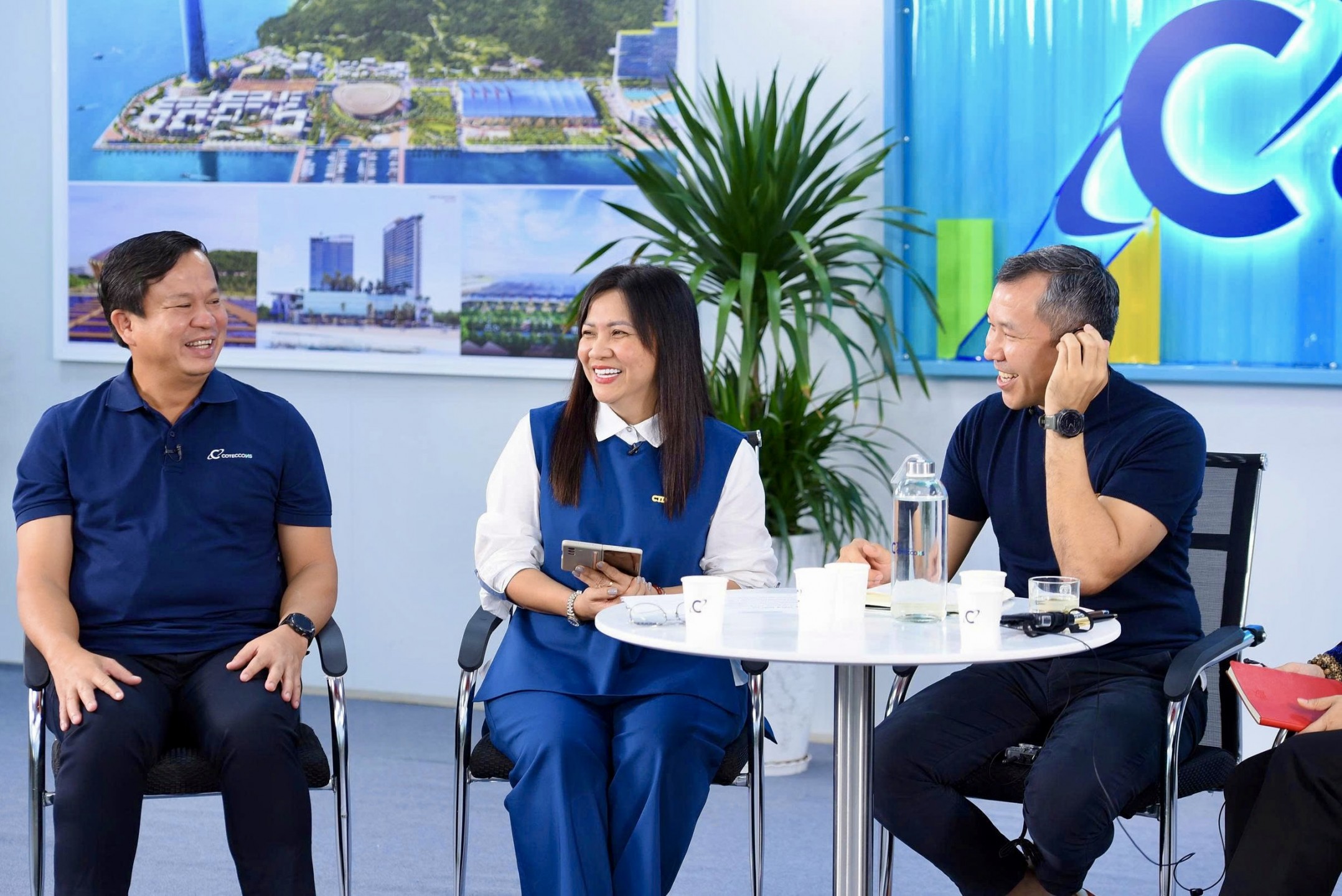
At the end of the day, I want to emphasize that instead of ‘running fast to win,’ Coteccons chooses to ‘run steady, run smart, and run energy-efficient,’ so that we can all reach the finish line together in a better way.
Is Coteccons experiencing any liquidity constraints at present?
- Does Coteccons’ 20% growth target refer to revenue or profit? And what are the main reasons behind the decline in gross profit margin?
Mr. Bolat Duisenov: Over the past four years, we have achieved an average annual revenue growth of 25–26%. With revenue now reaching around USD 1 billion, this is the right time for us to shift our focus from topline growth to operational efficiency. The lower-than-expected gross margin is largely due to external factors such as raw material price volatility and intense competition. Another factor is that the performance of our subsidiary, Unicons, has not met expectations during its restructuring process. However, our most important goal in the coming years is to enhance gross profit margins.
- How will the recovery of the 484 billion VND debt from Ngoi Sao Viet and other remaining bad debts proceed? How much provision reversal does the company expect in the upcoming fiscal year?
Mr. Bolat Duisenov: Regarding Ngoi Sao Viet, we have made a 100% provision and are currently undertaking legal procedures for recovery once the real estate market recovers.
Regarding provisions, it’s important to understand that these provisions are primarily established to address bad debts. In the past, this risk for Coteccons largely came from the civil construction segment. However, the current situation has improved significantly.
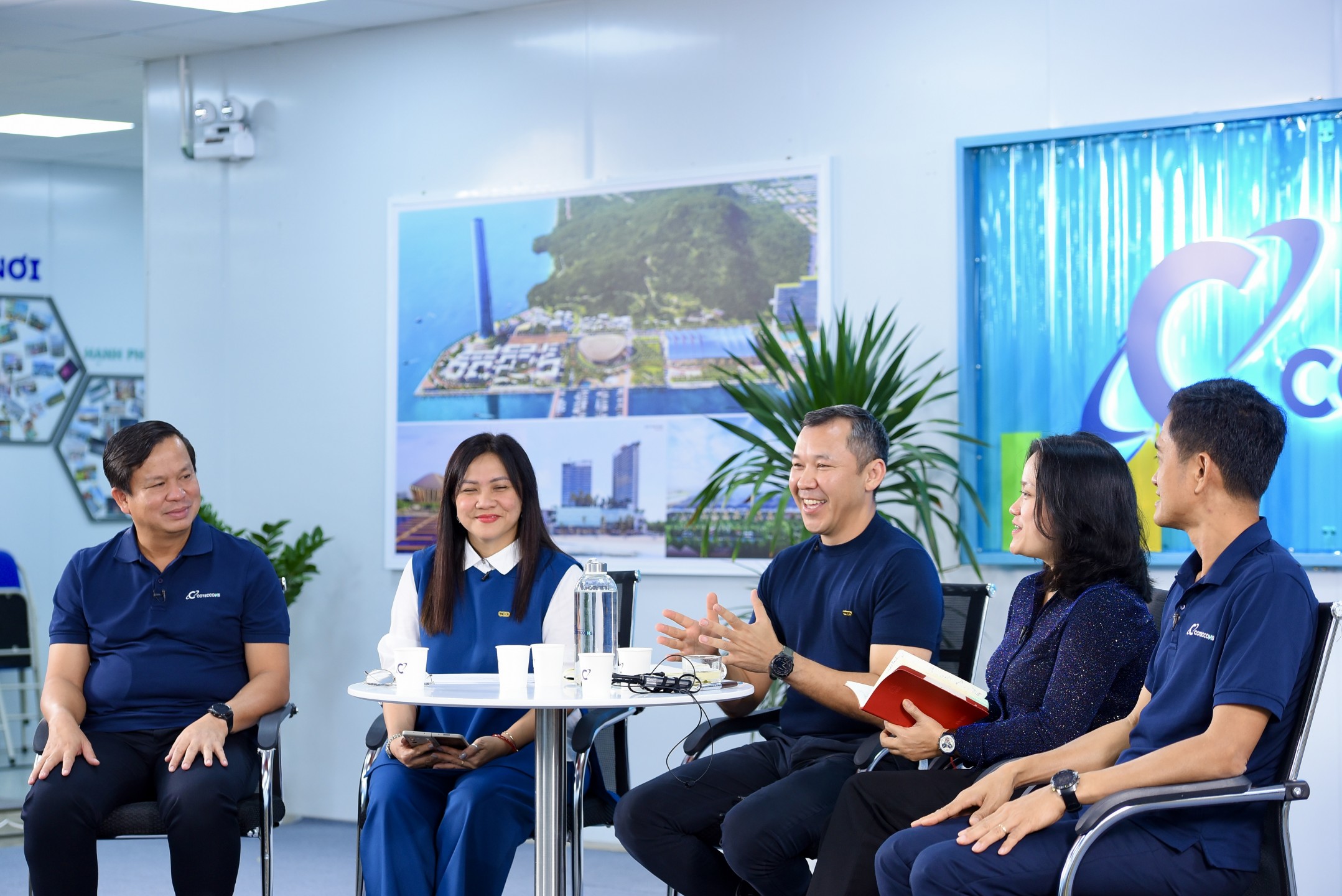
First, the civil construction market is experiencing a strong recovery, which helps mitigate risks from this segment. Second, and more importantly, Coteccons has proactively diversified its project portfolio. We are no longer reliant on a single source of revenue. Now, with contributions from other sectors such as industrial, infrastructure, and international markets, the company’s overall risk management capability has been markedly enhanced.
Mr. Nguyen Chi Thien: Regarding the reversal of provisions, this year’s objective for Coteccons to avoid additional provisioning while actively strengthening the recovery of outstanding debts. As previously committed, we have not increased provisions, and in practice, we have successfully adhered to this approach. To date, we have not encountered any new risks in this area. In construction, we must contend with schedule, quality, and safety, while also managing cash flow, costs, and bad debts.
- Accounts receivable are growing faster than revenue. Does this indicate that Coteccons is facing a cash shortage, and when will this improve?
Mr. Bolat Duisenov: Regarding receivables growing faster than revenue, this is characteristic of large-scale, fast-paced projects. Our clients are all well-established companies with strong financial capabilities. I can assure you that we are closely monitoring this matter. B By the end of this fiscal year and early next year, you will certainly see a significant improvement in cash flow.
- In recent years, Coteccons’ dividend payout has been quite low. Could the management consider a higher dividend this year, perhaps proposing 20% in cash and 20% in shares?
Mr. Bolat Duisenov: Thank you for your proposal. Our logic is to strike a balance between dividend distribution and reinvestment for the company’s sustainable growth. During the Covid-19 period, we were unable to distribute dividends. Over the past two years, we have maintained a 10% dividend payout. We will always consider options that ensure long-term growth while aligning with shareholders’ interests. While a higher dividend may provide short-term benefits, it could impact future strategic plans. We aim to position ourselves between these extremes—neither too high nor too low—based on business performance.
- Is the recent bond issuance targeting VND 1,400 billion intended to fund the Long An project?
Mr. Bolat Duisenov: There are multiple reasons for the bond issuance. First, it aims to balance our financial strategy between short-term and long-term capital. Second, it helps improve the company’s credit history. To answer directly, this bond issuance is not related to the Long An project. For Long An, we already have sufficient internal financial resources to ensure its execution.
Plan Regarding Ricons
- Does the Management Board have a roadmap for divesting from Ricons?
Mr. Bolat Duisenov: While we are indeed shareholders of Ricons, we do not hold any positions on the executive board or supervisory board. We feel that the two companies have limited alignment in terms of values and culture, and at times even compete with each other. We certainly intend to divest, but our approach will be to do so at a reasonable and fair price.
- Coteccons has approved a resolution to increase its foreign ownership limit from 49% to 100%. What is the current progress on this?
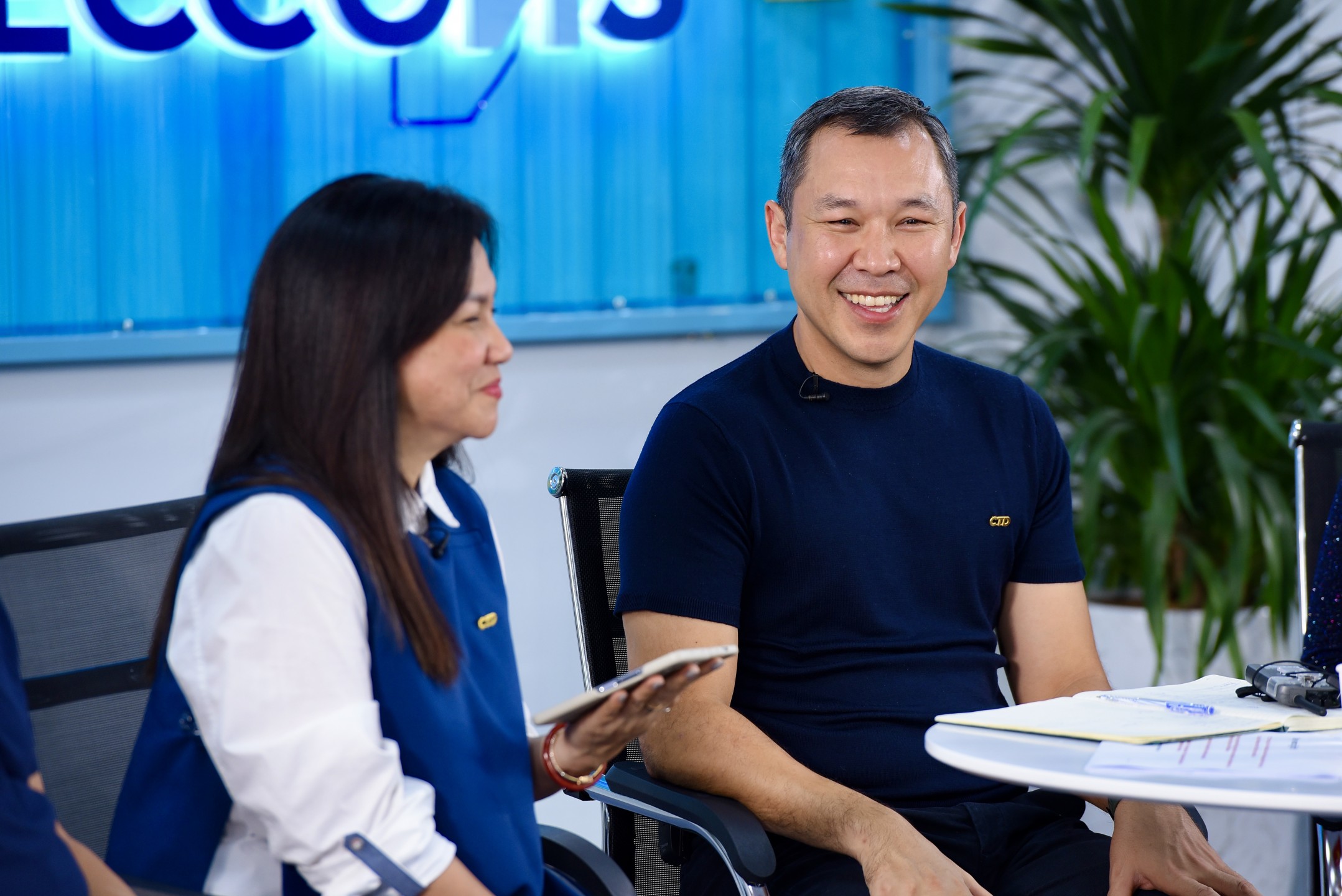
Mr. Bolat Duisenov: It’s true that the construction industry is not limited by foreign ownership caps, and we have already passed a resolution to increase the foreign room. However, we have been a bit slower than planned, but we have hired a third-party legal consultant to accompany and accelerate this process.
The backlog for Q1 2025 could reach 45,000–50,000 billion VND, reflecting Coteccons’ mission of serving the infrastructure and public investment sector.
- What is the proportion of civil, industrial, and infrastructure segments in the 35,000 billion VND backlog? What is the updated backlog for Q1 2025, and what is the average execution timeline?
Mr. Vo Hoang Lam: The segment distribution at Coteccons is fairly balanced. Of course, the civil construction segment is currently slightly larger, reflecting the recent recovery in the real estate market. At the beginning of the fiscal year, the backlog was over VND 35,000 billion. By the end of Q1 2025, we are updating the figures, but it is expected to increase significantly to around VND 45,000–50,000 billion. The average execution timeline for each project in the backlog is approximately two years.
- When Coteccons announced its restructuring strategy, the company indicated a shift toward infrastructure construction. However, looking back over the past five years, Coteccons has been absent from the North–South Expressway. Only recently has the company secured its first true infrastructure project on the western section of the North–South Expressway: Gia Nghĩa – Chơn Thành. How does the company evaluate the past five years, and what is Coteccons’ strategy going forward in the infrastructure segment?
Mr. Vo Hoang Lam: I understand that many expect immediate results. However, I would like to emphasize that Coteccons’ success today is not an overnight story. It is the outcome of a carefully planned journey that began from the very first days of our restructuring.
At that time, we spoke about the future, but we were also taking concrete preparatory actions. Today, we are witnessing a strong Coteccons re-emerge, as reflected in our revenue, profitability, and leading brand position in the industry. Similarly, our ability to secure major FDI projects and expand into international markets is also the result of this long-term preparation.
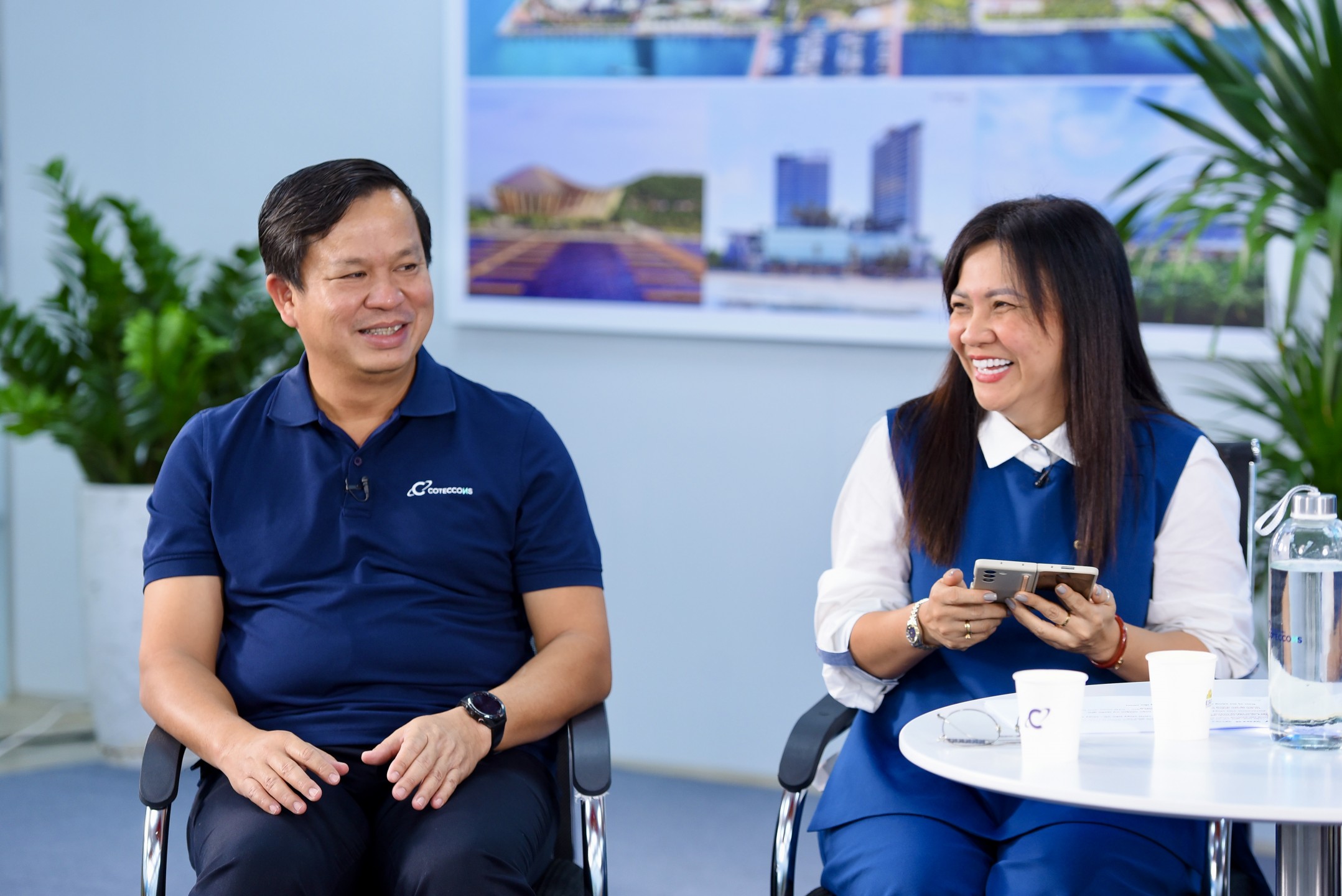
The same applies to the infrastructure segment. Many might view this as a large “piece of the pie,” but for us, it is first and foremost a responsibility. In line with our spirit of “Serving to Lead,” we don’t just think about winning projects, but also about how we contribute to the overall development of the country.
Infrastructure is more than highways or bridges. Most recently, the Thuy Van Beach renovation project in Vung Tau is a prime example; we didn’t just build, but also contributed to changing the face of an entire city, bringing practical value to its residents. Additionally, Coteccons is present in key national projects such as Long Thanh Airport (with the cargo terminal and other components) and, more recently, the Gia Nghia – Chon Thanh expressway.
We want to affirm that Coteccons does not focus on individual projects alone. We align ourselves with the country’s development. In nearly all major public investment projects, Coteccons is involved, either directly or through strategic partnerships. Future national priorities, such as Metro lines or even nuclear power plants, are areas where we see participation as both our responsibility and our mission.
“We are not ambitious in real estate”
- With Vietnam moving toward the development of high-tech centers, what has Coteccons prepared for this trend?
Mr. Nguyen Chi Thien: Our preparation began several years ago. While the market was heavily focused on real estate, Coteccons took a different path by building a team capable of handling projects with high technological requirements and complexity. As a result, when opportunities arose for projects like the LEGO factory, we were the pioneers. Moving forward, we are well-positioned to take on high-tech centers, financial hubs, data centers, and similar projects.
- What are the current sales results for The Emerald 68 project?
Mr. Nguyen Chi Thien: The current sales rate is approximately 80–90% sold. This is a project that Coteccons approached with the mindset of delivering the highest quality and the fastest progress.
Mr. Bolat Duisenov: Both this project and the Long An project provided us with experience to find a successful cooperation formula with developers. We are not ambitious to create our own real estate brand to compete with our own clients. The goal of The Emerald 68 is to introduce a mid-range segment project with premium quality and to create homeownership opportunities for our own employees. Currently, Coteccons employees account for about 10% of buyers at Emerald 68.
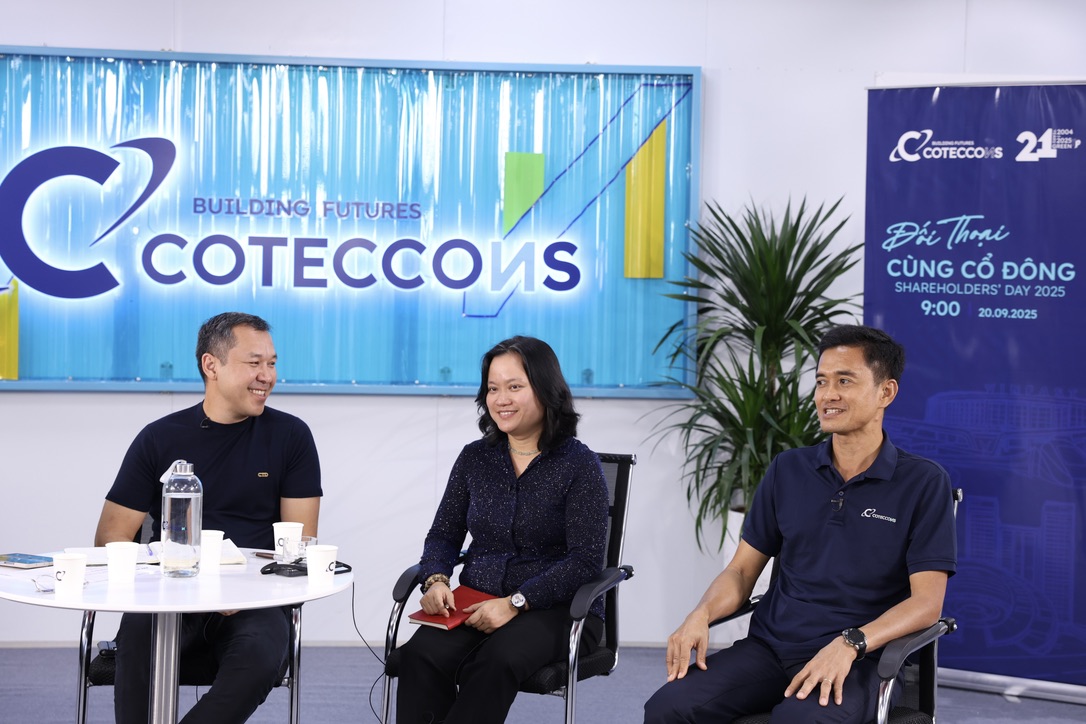
- Following the strategic partnership with Sun Group, does Coteccons plan to participate in their upcoming projects?
Mr. Nguyen Chi Thien: Coteccons is currently involved in a wide range of Sun Group projects, from high-rise to low-rise developments, in locations such as Đà Nẵng, Hà Nội, Phú Quốc, Hà Nam, Cát Bà, and Thanh Hóa. With a strategic client like Sun Group, we continue to earn their trust and have been entrusted with additional work on upcoming projects. We anticipate a significant volume of work with this developer in the near term
Mr. Vo Hoang Lam: Currently, the private sector is a key driver of the country’s development. In the near future, numerous major infrastructure projects will be undertaken by private corporations, including high-speed rail, metro lines, and ports—not only with Sun Group, but also Masterise, Vingroup, and others. Coteccons will play an integral role in supporting these initiatives.
- Recently, Coteccons successfully completed and handed over the Viet Ý Steel Factory project in Hải Phòng. Could the company share the challenges, advantages, and key milestones achieved during construction and handover?
Mr. Nguyen Chi Thien: For this project, the client was highly demanding with very stringent safety standards. We had to outperform several competitors, including Chinese contractors, to win the bid. It was a significant challenge, but we successfully delivered the project with excellence, earning the client’s trust. We are now in negotiations for follow-up projects with them.
Building Sustainable Trust
- Vietnam has many major holidays. What incentive policies do Coteccons have for its staff to boost morale and encourage them to stay on large construction sites during holidays and Tet?
Ms. Nguyen Thi Thanh Huong, Human Capital Director: For certain holidays throughout the year, Coteccons does not have specific bonus policies, as we prefer to focus on recognizing and rewarding employees’ contributions over the entire year through performance indicators. For major holidays, Coteccons continues to provide Tet bonuses. Additionally, we regularly conduct market research and surveys to ensure that every Coteccons employee receives competitive compensation and benefits.

- An economic cycle typically lasts around 10 years, and we are currently in the mid-cycle upswing. Although still in the early stage of growth, many companies have already experienced talent attrition due to poaching by competitors. How does Coteccons ensure it retains a high-quality workforce?
Ms. Nguyen Thi Thanh Huong: It is normal for employees to leave and new ones to join an organization. In fact, having no turnover is not necessarily a good sign. We do not retain staff by offering double salaries when they are poached. Our strategy focuses on sustainability. We invest in talent development through succession planning and nurturing young, capable employees. People may come for high pay, but they stay for the culture and work environment. We aim to make Coteccons a “second home” where everyone feels happy. We have also updated our reward policies—from long-term project completion bonuses, which could span 3–5 years, to annual performance bonuses that are transparent and timely.
- What is the most challenging project that Coteccons aspires to undertake in the future, and how does the Chairman “lifetime guarantee” shareholders’ trust?
Mr. Nguyen Chi Thien: Our most challenging “project” is not skyscrapers or long-span bridges but building sustainable trust with you—day by day, through concrete actions.
Mr. Vo Hoang Lam: A “lifetime guarantee” is more than a promise on paper. It is reflected in how we run our construction sites—with quality, transparency, and the professionalism of our Vietnamese engineers. Coteccons today has over 30,000 workers, more than 3,000 engineers, and thousands of shareholders by our side. Our most difficult —and most important —project is building happiness and trust for everyone who chooses to partner with Coteccons in shaping the future.
Mr. Bolat Duisenov: To secure a lifetime of trust from our shareholders, we must first build trust with those who walk alongside us. When our people are well taken care of, they deliver high-quality work to our clients. When we earn the trust of our clients, business results become solid—and that is how we maintain shareholders’ confidence. We do not promise to avoid every challenge, but we commit to always acting with transparency, integrity, and steadfast adherence to our core values. Thus, our most challenging project is building and sustaining trust—day by day, step by step—with humility and dedication. This is the greatest legacy Coteccons seeks to leave, not just for today, but for the future.
